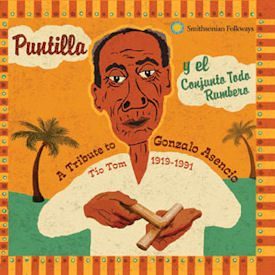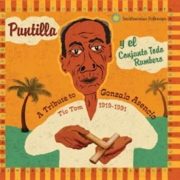PUNTILLA – TRIBUTE TO GONZALO ASENCIO, “TIO TOM”
Artists: Orlando “Puntilla” Rios Y
El Conjunto Todo Rumbero
Title: Tribute to Gonzalo Asencio, “Tio Tom”
Label: Smithsonian Folkways SFW40543

On any night of the week, you can find a club where couples are dancing salsa with frenetic energy. But when was the last time you saw a couple performing salsa’s honored ancestor, the rumba? The dance involves overtly flirtatious interplay between a man and a woman, the woman alternately enticing and protecting herself as the man tries to catch her off-guard with a vacunao — tagging her with the flip of a handkerchief or by throwing his arm, leg or pelvis in her direction in an act of symbolic sexual contact. It makes salsa look like a minuet.
Puntilla y El Conjunto Todo Rumbero: A Tribute to Gonzalo Asencio, “Tio Tom” is the first CD ever dedicated to the musician called “the Irving Berlin of the rumba” by Cuban record producer Rene Lopez. Gonzalo Asencio (1919-1991) was a top-notch composer-performer, mastering the singing, dancing, and drumming of an Afro-Cuban folkloric tradition that influenced the development of Latin musical forms in Cuba and the United States.
The rumba resulted from the cultural mix of people from diverse African backgrounds who migrated to port cities in Havana and Matanzas at the turn of the century. According to Cuban musicologist Leonardo Acosta, while these descendents of plantation slaves were seeking work, particularly as stevedores, they created vibrant new communities. Their frequent festive get-togethers were called rumba. Over time, the word came to signify the music and instrumentation played at such events. The guaguancó rumba, the couples dance with which Asencio is associated, most likely had roots in the yuca or macuta dances, which were both brought to Cuba by Bantú ethnic groups.
The port environment provided the original percussion instruments of the rumba – different-sized wooden shipping crates (cajones). Eventually these were replaced by conga drums (tumbadoras) of different sizes, ranging from a large, low-pitched drum, to a higher pitched one that keeps the combined triple and double-pulse length pattern throughout a number, and finally the smallest, highest pitched quinto, that plays more varied and improvised rhythms. Puntilla Rios and the Conjunto Todo Rumbero ably represent the interplay of the vocalist (Rios) with the instrumental ensemble, which also includes the claves and the cata, a small, hollowed tree trunk segment played with two small wooden sticks. The Conjunto adds a guiro (gourd rattle) to further enrich the sound.
The spontaneity of “Puntilla” Rios’s singing gives the impression that Puntilla is creating the rumbas on the spot. But no, Gonzalo Asencio composed all but one of the rumbas on this CD. The rumba form does give opportunities for improvisation, but mainly in the final montuno section of the piece. The opening sections contain the words and experience of Asencio. Eight of the rumbas on this tribute album represent the popular guaguanco rumba form that emerged from Havana and Matanzas Province, the rumba used in couple dancing and Asencio’s preferred style.
Composing from the age of 15 in a working class Havana neighborhood, Asencio listened to the great rumberos of the time. He gained his first recognition with an ingenious rumba that mixed the theme of love with the titles of the most famous Hollywood films of the time. This can be heard in Cut Five, Mal de yerba (The Bad Seed).
Solo, errante y bohemio (Alone, Errant, and Bohemian),Orlando Rios y El Conjunto Todo Rumbero Cut Four on the CD, recounts the lifestyle of the musician who came to be known affectionately to his peers as Tio Tom.
They say I am a lost soul
Alone, errant, and a Bohemian/Listen, they say I am a drunkard
Everything has its mystery
His street existence and his wariness of organizations and authority explain why, despite the hundreds of rumba numbers now attributed to him, Gonzalo Asencio never became a household name in his native Cuba. During his prolific years, more business-savvy musicians adopted and took credit for many of his compositions.
Donde estan los cubanos (Where are the Cubans), Cut Six, represents Asencio’s uncompromising values in the midst of what seemed to be a dissolute lifestyle. One of his best known songs, it expresses his outrage at the desecration of the statue of Cuban hero Jose Marti (1853-1895) a revered poet and statesman, by American sailors. This open criticism, albeit couched in music, implicated then Cuban President Carlos Prio Socarras: Listen, Mr. President
I want to know your opinion
About the talk of how the Cubans have acted
Toward the American who came from abroad
To trample the flag and our Cuban apostle, Jose Marti.
The President responded by giving the song’s author time in jail. This did not deter Tio Tom from composing other controversial rumbas on subjects such as racism.
Those of us who have not (yet) mastered Spanish may revel in the deft vocal line and explosive polyrhythms of Asencio’s rumbas but unfortunately, even translations, do not fully convey, in Leonardo Acosta’s words “how he combines a festive spirit with love, nostalgia, irony and satirical joking, grace, social denunciation, violence, kindness, and tenderness: that is, practically the entire register of human emotions and feelings.”
Before Gonzalo Asencio passed away in 1991, he finally began to receive national recognition, thanks to a group of fellow musicians who helped him transcribe and register his songs, gaining him composer’s rights. A tribute to him took place in Havana’s Plaza of the Revolution Cultural Center in 1982.
The ninth cut on the CD, Tio Columbia (Uncle Columbia) is an homage to Ascencio composed by the lead performer on this album, Orlando Rios and composer Ernesto Gatel. While rumba novices might not notice a great difference in style, the rumba Columbia used here displays a more aggressive triple meter than the more restrained duple-meter of the guaguanco. The number ends with a third montuno refrain of salaam aleichem (peace be with you).
This gem of a CD turns out to honor not only the rumbero Gonzalo Ascencio but also the musician who gave the tribute project musical life, Orlando “Puntilla” Rios. Leading the talented Conjunto Todo Rumbera to interpret Ascencio’s work turned out to be the master vocalist and percussionist’s final recording. He passed away in New York on August 12, 2008.
Unlike Gonzalo Ascencio, Orlando Rios earned success and recognition early in his career. In Cuba, he made his musical reputation playing in legendary cabarets of large hotels like the Tropicana. During the 1970s he taught at the prestigious National School of Art. His decision in 1980 to leave Cuba and settle in New York brought new dimensions of Afro-Cuban percussion to the burgeoning Latino music scene in the United States. Puntilla taught and mentored musicians learning to play the two-headed bata drum used in the religious Santeria ceremonies, the conga drums, and a variety percussion instruments. An excellent representative recording is Spirit Rhythms: Sacred Drumming and Chants from Cuba, released in 1996. With his band Nueva Generacion, he accompanied Latin music stars such as Celia Cruz and Tito Puente.
Yet these two musical giants, Orlando “Puntillo” Rios and Gonzalo Asencio drew inspiration from the same wellspring – the Afro-Cuban folkloric experience that continues to entrance musicians and entertain audiences the world over.
Audrey Coleman is a writer, educator, and passionate explorer of world music and culture. Research for the above article came from classes she took in UCLA’s Department of Ethnomusicology, from forays into The Rough Guide to World Music, Volume 2 (Rough Guides Limited, London, Penguin Books, 2000), and from obsessive listening and web-surfing on the subject.













